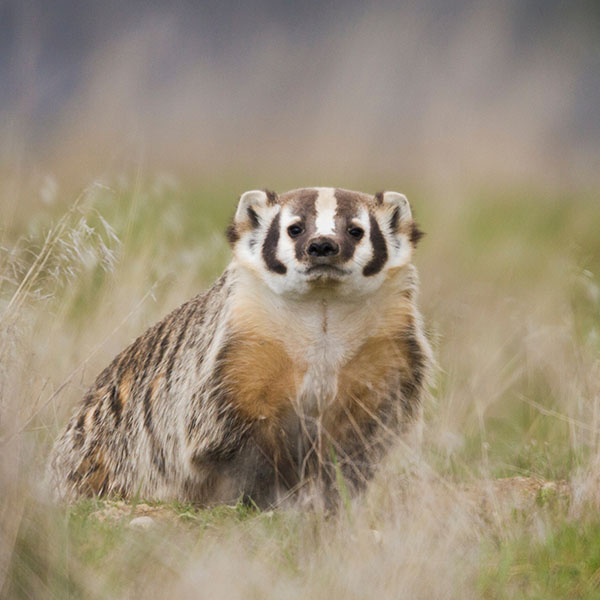American Badger
Taxidea taxus

Animal Ambassadors
American badgers specialize in hunting burrowing rodents, so they are built for digging. They use their impressively long front claws to dig out dirt which they kick out behind them with their stubby hind legs. Their eyes have nictitating membranes to keep out debris and their ear canals are small to prevent blockage. Additionally, their loose skin allows them to turn around in tight underground corridors. Badgers can dig a burrow, hide inside it, and plug the entrance behind them in less than 90 seconds! These amazing diggers have even been documented to dig through concrete! Badgers primarily feed on ground squirrels and prairie dogs, both of which are known for digging tunnels with lots of escape routes. Interestingly, badgers frequently block these extra entrances with dirt, rocks, or wood chunks before digging into the main nest. Some researchers also believe that badgers and coyotes hunt cooperatively; coyotes often wait nearby while badgers are hunting, snagging rodents as they run out of the tunnels to escape. It’s possible that some rodents spot the coyotes waiting outside and turn back around, which would then benefit the badgers as well.
In addition to controlling rodent populations, American badgers are vital to creating healthy ecosystems. A single badger is estimated to dig at least 1,100-1,700 burrows every year! By churning up that much soil, they distribute important nutrients and mix soil types. This allows for greater plant diversity. Additionally, abandoned badger burrows create homes for a wide range of other species, including spiders, snakes, lizards, burrowing owls, rabbits, skunks, and rodents. Coyotes are the main predator of badgers, although bears, cougars, wolves, golden eagles, and other badgers can also pose a threat. However, badgers have been known to stand down bears, cougars, and even vehicles! Their black-and-white facial markings are thought to make these tenacious predators stand out and to warn potential attackers to stay away.
Ground squirrels, prairie dogs, small rodents, skunks, hares, reptiles (including rattlesnakes), insects, honey, fruit, carrion
Most of western and central North America
4-12 years / up to 25 years
Open grassland, high sagebrush, open desert, open woodlands
16-28 inches
8-26 lbs
